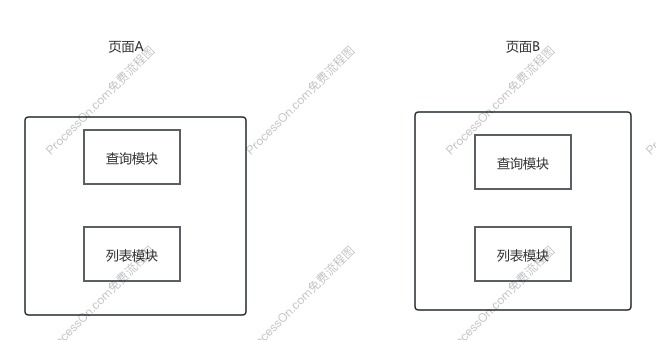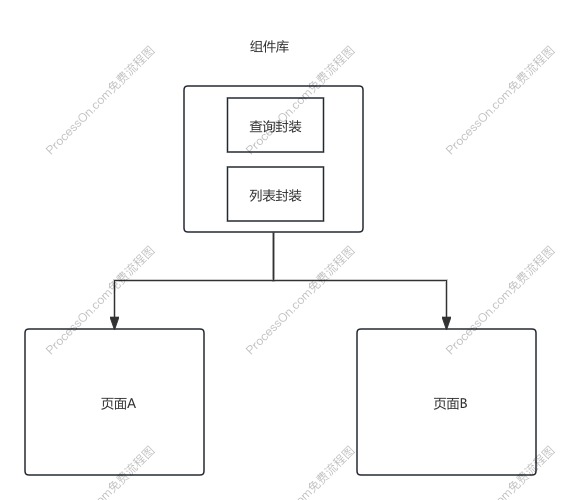- Published on
如何设计一个模块动态加载功能
- Authors

- Name
- noodles
- 每个人的花期不同,不必在乎别人比你提前拥有
在工程领域,工程师似乎经历了这样的变化
- 人工时代
- 工具时代
- 工程时代
- 智能(AI)时代
在人工时代,大部分工作都是Pro Code方式完成. 
在上面的两个模块中,可以看到它们是有相似的功能的.但是在实现上会偏重复的方式实现,这个时候对工程师的数量需求很大,对工程师的'能力'要求低. 这里的'能力'是指解决复杂场景或者提效的能力.
在工具时代,我们会抽象工具,帮助实现提效/复用/约束等目的.这个时候对工程师的能力就需要对业务有理解能力.

在上面的两个模块中,可以看到它们是有相似的功能的.但是在实现上会偏重复的方式实现,这个时候对工程师的数量需求很大,对工程师的'能力'要求低. 这里的'能力'是指解决复杂场景或者提效的能力.
在工具时代,我们会抽象工具,帮助实现提效/复用/约束等目的.这个时候对工程师的能力就需要对业务有理解能力.

工程时代我们似乎已经走到了尾声,现在正在处于一个工程时代向智能时代的过渡阶段.在工程时代,工程师需要从工程架构上去解决业务问题.

在这个过渡阶段,理解工具/工程还是有很大意义.在理解工具或者工程的组织方式的基础上,才能更好的利用AI实现对应的功能.
此处是正文分割线
回归到标题,模块的动态加载功能是前端比较常见的场景,通过动态加载的方式可以减少主bundle的体积从而一定程度上提升页面加载速度.从手动的指定模块动态加载 到自动化实现模块的自动加载可以看做是靠近智能化的'一小步'.下面我们就看看如何在项目中实现模块的动态加载.
模块自动动态引入
在webpack的编译过程中,会给我们暴露一些钩子,通过监听对应的钩子就可以影响编译内容的产生.在实现模块自动动态引入这个功能,可以通过监听钩子自动的在对应的 目录下生成内容,从而完成自动动态引入.

class ModalMapPlugin {
apply(compiler) {
compiler.hooks.afterPlugins.tap('ModalMapPlugin', () => {
// 监听afterPlugins钩子回调
const modalMap = {}
const modalsDir = path.resolve(process.cwd(), 'src/Modal')
function scanDir(dir) {
try {
const files = fs.readdirSync(dir)
// 扫描对应的目录并且生成动态引入内容
files.forEach((file) => {
const fullPath = path.join(dir, file)
const stat = fs.statSync(fullPath)
if (stat.isDirectory()) {
const indexPath = path.join(fullPath, 'index.tsx')
if (fs.existsSync(indexPath)) {
const relativePath = path.relative(modalsDir, fullPath)
const componentName = relativePath.split(path.sep)[0]
modalMap[componentName] =
`React.lazy(() => import('@/Modal/${componentName}/index.tsx'))`
}
}
})
} catch (error) {
console.error('扫描目录出错:', error)
}
}
try {
scanDir(modalsDir)
// 生成动态引入内容
const content = `
import React from 'react';
export const modalComponentMap = {
${Object.entries(modalMap)
.map(([key, value]) => `"${key}": ${value}`)
.join(',\n ')}
};`
// 生成类型定义内容
const typeContent = `import { LazyExoticComponent } from 'react';
export type ModalComponentType = ${Object.keys(modalMap)
.map((key) => `"${key}"`)
.join(' | ')};
export const modalComponentMap: Record<ModalComponentType, LazyExoticComponent<any>>;`
// 确保输出目录存在
const outputDir = path.resolve(process.cwd(), 'src/utils')
if (!fs.existsSync(outputDir)) {
fs.mkdirSync(outputDir, { recursive: true })
}
// 写入 JS 文件
const outputPath = path.join(outputDir, 'modalMap.js')
fs.writeFileSync(outputPath, content)
// 写入类型定义文件
const typeOutputPath = path.join(outputDir, 'modalMap.d.ts')
fs.writeFileSync(typeOutputPath, typeContent)
} catch (error) {
console.error('生成映射文件出错:', error)
}
})
}
}
防劣化设计
类型
在生成动态引入的时候同时生成了类型,这样在使用的时候错误的类型就会报ts的类型错误
import { LazyExoticComponent } from 'react';
export type ModalComponentType = "AAModal" | "testModal";
export const modalComponentMap: Record<ModalComponentType, LazyExoticComponent<any>>;
引用方式限制
如果对应目录下的包通过直接引用的方式还是会被打进主包,可以通过增加eslint的rules来解决
rules: {
'no-restricted-imports': ['warn', {
patterns: [{
group: ['**/Modal/*'],
message: '请使用 React.lazy 懒加载 Modal 组件,例如:\nconst Component = React.lazy(() => import("@/Modal/Component"));'
}]
}],
}
使用
在使用上可以通过Suspense包裹对应的组件,数据可以通过自定义事件或者props的方式传递
// 使用方式
const App = () => {
const [showModal, setShowModal] = useState(false)
const ModalComponent = modalComponentMap['AsModal']
return (
<div>
<button onClick={() => setShowModal(true)}>打开弹窗</button>
{showModal && (
<Suspense fallback={<div>加载中...</div>}>
{/* @ts-ignore */}
<ModalComponent isOpen={showModal} onClose={() => setShowModal(false)} />
</Suspense>
)}
</div>
)
}
在调用的时候,动态加载了对应的模块

